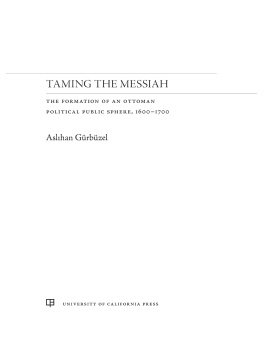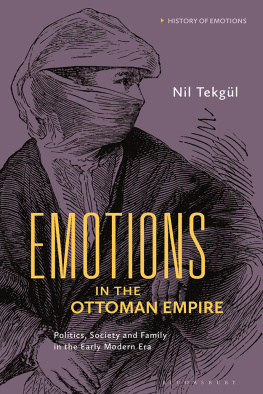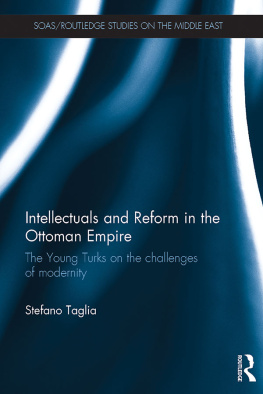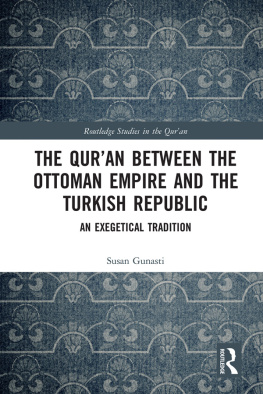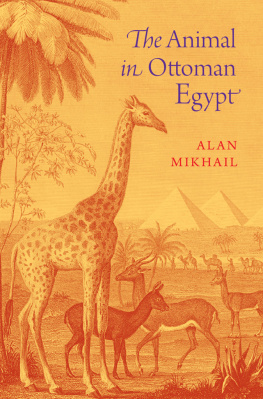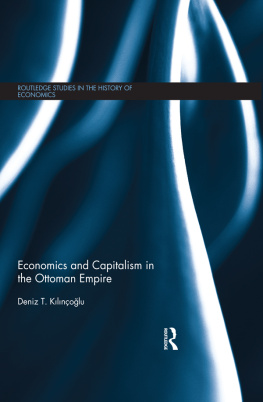Names: Grbzel, Aslhan, author.
Title: Taming the Messiah : the formation of an Ottoman political public sphere, 16001700 / Aslhan Grbzel.
Description: [Oakland, California] : [University of California Press], [2022] | Includes bibliographical references and index.
Identifiers: LCCN 2022024388 (print) | LCCN 2022024389 (ebook) | ISBN 9780520388215 (hardback) | ISBN 9780520388222 (ebook)
Subjects: LCSH : MevleviyehTurkey17th century. | TurkeyHistoryOttoman Empire, 12881918. | TurkeyPolitics and government17th century.
Classification: LCC DR 485 . G 87 2022 (print) | LCC DR 485 (ebook) | DDC 949.61/015dc23/eng/20220623
ACKNOWLEDGMENTS
While an economics major at Bilkent University, my interest in Ottoman history was initially inspired by Zeynep Yreklis teaching and mentorship. I was fortunate to take courses with zer Ergen and Eugenia Kermeli while studying for my masters at Bilkent. The research that resulted in this book began during my graduate studies at Harvard University. I would like to thank my PhD supervisor Cemal Kafadar for sharing his boundless passion for Ottoman cultural and intellectual history with me. I am thankful for his long, engaging, and exquisite seminars, which I will always cherish. He taught me to approach the linguistic and cultural worlds of texts with genuine openness and humbleness, and to avoid the enormous condescension of posterity, as E.P. Thompson famously remarked, when facing the intricate intellectual world of early modern Rms. At Harvard, I was also fortunate to study with Khaled el-Rouayheb and learned much from his approach to Islamic intellectual history. Ann Blair has been an invaluable guide in early modern cultural and intellectual history, and a generous and reliable mentor throughout. I am also grateful to Dana Sajdi for the careful reading and honest and engaged feedback she has provided on my work; she has made me a better writer and a better communicator of ideas. I cannot imagine what my graduate training would have looked like without the mentorship of the late Shahab Ahmed, who treated me as a colleague from my first day at Harvard on. He generously shared with me his projects and ideas at various stages of their development, always sprinkled with his unmatched sense of humor. I am forever grateful for the intellectual stimulation and challenge he consistently provided to me during my years at Harvard.
This book took its present shape at McGill Universitys Institute of Islamic Studies, where I found a welcoming home after completing my PhD. I am grateful to all my colleagues at the Institute for providing me with an exceptionally supportive environment. I am particularly indebted to Laila Parsons and Michelle Hartman. I cannot count the number of times they offered me support, encouragement, and guidance over the past five years. In order to complete this manuscript, I took a postdoctoral fellowship at Ko Universitys RCAC (Research Center for Anatolian Studies). Without this fellowship, I would not have been able to conduct brand-new research and to entirely reconceptualize my project. I thank Buket Cokuner, Chris Roosevelt, and the RCAC crew and fellows for this fellowship period. I am particularly grateful to Zeynep Aydoan, Mge Telci zbek, and the late Yavuz Sezer for their companionship during this year.
The ideas in this book developed in conversation with many colleagues and audiences over the past six years. I am grateful to my colleagues Baki Tezcan and Kaya ahin for providing me with engaged and challenging feedback on parts of my argument, while being extremely supportive and encouraging throughout. I am also grateful for the many conversations I have had over the years with Selim Srr Kuru, Ali Yaycolu, Evren Snnetiolu, Akif Yerliolu, Kameliya Atanasova, Yavuz Aykan, Jonathan Allen, and Nir Shafir. Feedback that I received from audiences at the final stages of drafting the book has been particularly crucial. For these opportunities to present my work in progress, I thank Ali Yaycolu and the Eurasian Empires Workshop at Stanford University, Ferenc Pter Csirks and the History Department at Sabanc University, Mehmet Kentel and the Istanbul Research Institute, Nir Shafir and the History Department at the University of California, San Diego, and Derin Terziolu and the Nafi Baba Center of Sufism Studies at Boazii University. The three anonymous reviewers for the University of California Press have saved me from many errors, and gave the first draft of this book important new directions. At the University of California Press, I was also fortunate to receive the guidance of the members of the editorial board and of my editors, LeKeisha Hughes and Eric Schmidt. Jessica Stilwells careful editing has given my book a much better flow than it would otherwise have. An earlier version of chapter 5 was published in Brills Philological Encounters. I am grateful to the journal for allowing me to republish my work as part of this book.
As I conclude the project, it is a pleasure to thank my friends and family for supporting me throughout these years. I am grateful to my dear friends Ayegl Ynet, Derya Kl, Akif Ercihan Yerliolu, Aytu amaz, Ardeta Gjikola, and Elena Razlogova, who supported me with their company, encouragement, belief in me, and good humor through these years. Last but not least, I thank my parents Ramazan and Keziban Grbzel for always taking pride in everything I do, and for supporting me in my pursuits. My sisters, Mnire and Merve, are the funniest people alive, and I cannot thank them enough for the joy they bring to my days.
CONVENTIONS USED
ABBREVIATIONS
DBA | Dnden Bugne stanbul Ansiklopedisi |
DA | Trkiye Diyanet Vakf slam Ansiklopedisi |
EI2 | The Encyclopedia of Islam, 2nd ed. |
EI3 | The Encyclopedia of Islam, 3rd ed. |
TRANSLITERATION AND DATES
Names, terms, and citations have been transliterated with a version of the IJMES system adapted to Ottoman Turkish by adding , , , , and making the concurrent vowel changes. For Ottoman geographical names, modern Turkish orthography is adopted, except when there is an English equivalent for the latter: hence, for instance, Istanbul instead of stanbul, Cairo instead of Kahire, Damascus instead of am. For terms that appear in Merriam-Websters Dictionary , Anglicized spellings have been preferredfor example, sharia, waqf, vizier, janissary.
Terms of Arabic origin that have broader relevance in the field of Islamic Studies have been retained in standard IJMES transliteration. Hence, sam instead of sem, Mujaddid instead of Mceddid. In cases where a transliterated edition has been used, I follow the editors transliteration choicesfor example, Seyahatname instead of Seyaatnme.
Although the original sources discussed here use the hijr calendar, throughout this book dates are given in the Common Era.

